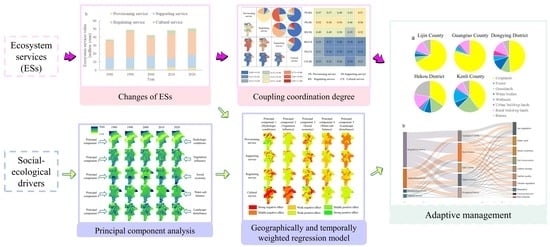Spatiotemporal Heterogeneity of Coastal Wetland Ecosystem Services in the Yellow River Delta and Their Response to Multiple Drivers
Abstract
1. Introduction
2. Materials and Methods
2.1. Study Area
2.2. Data Sources
2.3. ES Assessment
2.3.1. Equivalent Value Factors (EVF) Method
2.3.2. WY
2.3.3. Ca
2.3.4. SC
2.3.5. GR
2.4. Quantification of Correlations between ESs
2.4.1. Correlation Analysis
2.4.2. CCD Model
2.5. Social–Ecological Drivers of ESs
2.5.1. Selection of Social–Ecological Drivers
2.5.2. PCA
2.5.3. The GTWR Model
3. Results
3.1. Spatiotemporal Variations of ESs
3.1.1. Spatiotemporal Variations
3.1.2. Trade-Offs and Synergies between ESs
3.2. CCD Evaluation
3.3. GTWR Analysis of Multiple Drivers and ESs
3.3.1. PCA
3.3.2. GTWR Analysis
4. Discussion
4.1. Reasons for Spatiotemporal Variation of ESs
4.2. Trade-Offs/Synergies Based on the CCD Model and Correlation
4.3. Response of ESs to Multiple Drivers
4.4. Spatial Planning and Management
4.5. Limitations and Prospects
5. Conclusions
Supplementary Materials
Author Contributions
Funding
Data Availability Statement
Conflicts of Interest
References
- Temmink, R.J.M.; Lamers, L.P.M.; Angelini, C.; Bouma, T.J.; Fritz, C.; van de Koppel, J.; Lexmond, R.; Rietkerk, M.; Silliman, B.R.; Joosten, H.; et al. Recovering Wetland Biogeomorphic Feedbacks to Restore the World’s Biotic Carbon Hotspots. Science 2022, 376, eabn1479. [Google Scholar] [CrossRef] [PubMed]
- Bratman, G.; Anderson, C.; Berman, M.; Cochran, B.; de Vries, S.; Flanders, J.; Folke, C.; Frumkin, H.; Gross, J.; Hartig, T.; et al. Nature and Mental Health: An Ecosystem Service Perspective. Sci. Adv. 2019, 5, eaax0903. [Google Scholar] [CrossRef] [PubMed]
- Costanza, R.; de Groot, R.; Braat, L.; Kubiszewski, I.; Fioramonti, L.; Sutton, P.; Farber, S.; Grasso, M. Twenty Years of Ecosystem Services: How Far Have we Come and How Far Do we Still Need to Go? Ecosyst. Serv. 2017, 28, 1–16. [Google Scholar] [CrossRef]
- Murray, N.J.; Worthington, T.A.; Bunting, P.; Duce, S.; Hagger, V.; Lovelock, C.E.; Lucas, R.; Saunders, M.I.; Sheaves, M.; Spalding, M.; et al. High-Resolution Mapping of Losses and Gains of Earth’s Tidal Wetlands. Science 2022, 376, 744–749. [Google Scholar] [CrossRef] [PubMed]
- Fluet-Chouinard, E.; Stocker, B.D.; Zhang, Z.; Malhotra, A.; Melton, J.R.; Poulter, B.; Kaplan, J.O.; Goldewijk, K.K.; Siebert, S.; Minayeva, T.; et al. Extensive Global Wetland Loss over the Past Three Centuries. Nature 2023, 614, 281–286. [Google Scholar] [CrossRef] [PubMed]
- Sun, Z.; Sun, W.; Tong, C.; Zeng, C.; Yu, X.; Mou, X. China’s Coastal Wetlands: Conservation History, Implementation Efforts, Existing Issues and Strategies for Future Improvement. Environ. Int. 2015, 79, 25–41. [Google Scholar] [CrossRef]
- Lopes, R.; Videira, N. Valuing Marine and Coastal Ecosystem Services: An Integrated Participatory Framework. Ocean. Coast. Manag. 2013, 84, 153–163. [Google Scholar] [CrossRef]
- Ren, J.; Chen, J.; Xu, C.; van de Koppel, J.; Thomsen, M.S.; Qiu, S.; Cheng, F.; Song, W.; Liu, Q.; Xu, C.; et al. An Invasive Species Erodes the Performance of Coastal Wetland Protected Areas. Sci. Adv. 2021, 7, eabi8943. [Google Scholar] [CrossRef]
- Fu, Q.; Hou, Y.; Wang, B.; Bi, X.; Li, B.; Zhang, X. Scenario Analysis of Ecosystem Service Changes and Interactions in a Mountain-Oasis-Desert System: A Case Study in Altay Prefecture, China. Sci. Rep. 2018, 8, 12939. [Google Scholar] [CrossRef]
- Yin, L.; Zheng, W.; Shi, H.; Ding, D. Ecosystem Services Assessment and Sensitivity Analysis Based on ANN Model and Spatial Data: A Case Study in Miaodao Archipelago. Ecol. Indic. 2022, 135, 108511. [Google Scholar] [CrossRef]
- Zhang, T.; Zhang, S.; Cao, Q.; Wang, H.; Li, Y. The Spatiotemporal Dynamics of Ecosystem Services Bundles and the Social-Economic-Ecological Drivers in the Yellow River Delta Region. Ecol. Indic. 2022, 135, 108573. [Google Scholar] [CrossRef]
- Su, S.; Xiao, R.; Jiang, Z.; Zhang, Y. Characterizing Landscape Pattern and Ecosystem Service Value Changes for Urbanization Impacts at an Eco-Regional Scale. Appl. Geogr. 2012, 34, 295–305. [Google Scholar] [CrossRef]
- Wang, C.; Li, X.; Yu, H.; Wang, Y. Tracing the Spatial Variation and Value Change of Ecosystem Services in Yellow River Delta, China. Ecol. Indic. 2019, 96, 270–277. [Google Scholar] [CrossRef]
- Ma, M.; Tang, J. Interactive Coercive Relationship and Spatio-Temporal Coupling Coordination Degree Between Tourism Urbanization and Eco-Environment: A Case Study in Western China. Ecol. Indic. 2022, 142, 109149. [Google Scholar] [CrossRef]
- Shi, H.; Yin, L.; Gao, M. Landscape Changes and their Ecological Effects of Miaodao Archipelago with Human Disturbances and Under Natural Conditions in the Past 30 Years. J. Oceanol. Limnol. 2021, 39, 955–978. [Google Scholar] [CrossRef]
- Chi, Y.; Shi, H.; Sun, J.; Li, J.; Yang, F.; Fu, Z. Spatio-Temporal Characteristics and Main Influencing Factors of Vegetation Net Primary Productivity in the Yellow River Delta in Recent 30 Years. Acta Ecol. Sin. 2018, 38, 2683–2697. [Google Scholar]
- Liu, R.X.; Kuang, J.; Gong, Q.; Hou, X.L. Principal Component Regression Analysis with SPSS. Comput. Methods Programs Biomed. 2003, 71, 141–147. [Google Scholar] [CrossRef] [PubMed]
- Chi, Y.; Shi, H.; Zheng, W.; Sun, J.; Fu, Z. Spatiotemporal Characteristics and Ecological Effects of the Human Interference Index of the Yellow River Delta in the Last 30 Years. Ecol. Indic. 2018, 89, 880–892. [Google Scholar] [CrossRef]
- Chi, Y.; Zheng, W.; Shi, H.; Sun, J.; Fu, Z. Spatial Heterogeneity of Estuarine Wetland Ecosystem Health Influenced by Complex Natural and Anthropogenic Factors. Sci. Total Environ. 2018, 634, 1445–1462. [Google Scholar] [CrossRef]
- Schröter, D.; Cramer, W.; Leemans, R.; Prentice, I.; Araújo, M.; Arnell, N.; Bondeau, A.; Bugmann, H.; Carter, T.; Gracia, C.; et al. Ecosystem Service Supply and Vulnerability to Global Change in Europe. Science 2005, 310, 1333–1337. [Google Scholar] [CrossRef]
- Li, J.; Gong, Y.; Jiang, C. Spatio-Temporal Differentiation and Policy Optimization of Ecological Well-Being in the Yellow River Delta High-Efficiency Eco-Economic Zone. J. Clean. Prod. 2022, 339, 130717. [Google Scholar] [CrossRef]
- Zhang, X.; Wang, G.; Xue, B.; Zhang, M.; Tan, Z. Dynamic Landscapes and the Driving Forces in the Yellow River Delta Wetland Region in the Past Four Decades. Sci. Total Environ. 2021, 787, 147644. [Google Scholar] [CrossRef] [PubMed]
- Fick, S.E.; Hijmans, R.J. WorldClim 2: New 1Km Spatial Resolution Climate Surfaces for Global Land Areas. Int. J. Climatol. 2017, 37, 4302–4315. [Google Scholar] [CrossRef]
- Harris, I.; Jones, P.; Osborn, T.; Lister, D. Updated High-Resolution Grids of Monthly Climatic Observations—The CRU TS3.10 Dataset. Int. J. Climatol. 2014, 34, 623–642. [Google Scholar] [CrossRef]
- Yue, T.; Yin, S.; Xie, Y.; Yu, B.; Liu, B. Rainfall Erosivity Mapping Over Mainland China Based on High-Density Hourly Rainfall Records. Earth Syst. Sci. Data 2022, 14, 665–682. [Google Scholar] [CrossRef]
- Millennium Ecological Assessment. Ecosystems and Human Well-Being: A Framework for Assessment; Island Press: Washington, DC, USA, 2005. [Google Scholar]
- Xie, G.D.; Zhen, L.; Lu, C.X.; Xiao, Y.; Chen, C. Expert Knowledge Based Valuation Method of Ecosystem Services in China. J. Nat. Resour. 2008, 23, 911–919. [Google Scholar]
- Tian, J.; Jia, W. Study of Biodiversity in the Yellow River Delta; Qingdao Press: Qingdao, China, 1999. (In Chinese) [Google Scholar]
- Song, C.Y.; Liu, G.; Liu, Q.; Cao, M.; Huang, C. Distribution Patterns of Plant Communities in the Yellow River Delta and Related Affecting Factors. Chin. J. Ecol. 2008, 27, 2042–2048. [Google Scholar]
- He, H.; Pan, Y.; Zhu, W.; Liu, X.; Zhang, Q.; Zhu, X. Measurement of Terrestrial Ecosystem Service Value in China. J. Appl. Ecol. 2005, 16, 1122–1127. [Google Scholar]
- State Environmental Protection Administration. China Biodiversity Country Study; China Environmental Science Press: Beijing, China, 1997. (In Chinese) [Google Scholar]
- State Forestry Administration. Forest Ecosystem Service Function Evaluation Specification; China Standard Press: Beijing, China, 2008. (In Chinese) [Google Scholar]
- Ouyang, Z.Y.; Wang, X.; Miao, H. A Primary Study on Chinese Terrestrial Ecosystem Services and their Ecological-Economic Values. Acta Ecol. Sin. 1999, 10, 606–613. [Google Scholar]
- Li, F.; Zhang, B.; Zhang, S.Q. Ecosystem Service Valuation of Sanjiang Plain. J. Arid. Land Resour. Environ. 2004, 18, 19–23. [Google Scholar]
- Chun, Z. Loss Assessment of the Ecosystem Service Values of the Sanjiang Plain from 1954 to 2005. Syst. Sci. Compr. Stud. Agric. 2011, 27, 240–247. [Google Scholar]
- Sun, Y.; Liu, S.; Dong, Y.; An, Y.; Shi, F.; Dong, S.; Liu, G. Spatio-Temporal Evolution Scenarios and the Coupling Analysis of Ecosystem Services with Land Use Change in China. Sci. Total Environ. 2019, 681, 211–225. [Google Scholar] [CrossRef] [PubMed]
- Grimm, N.; Faeth, S.; Golubiewski, N.; Redman, C.; Wu, J.; Bai, X.; Briggs, J. Global Change and the Ecology of Cities. Science 2008, 319, 756–760. [Google Scholar] [CrossRef]
- Bo, N.; Zihan, Y.; Xu, B. Spatial-Temporal Correlation Analysis of Ecosystem Services Value and Human Activities: A Case Study of Huayang Lakes Area in the Middle Reaches of Yangtze River. China Environ. Sci. 2018, 38, 3531–3541. [Google Scholar]
- Fuh, B.P. On the Calculation of the Evaporation From Land Surface. Sci. Atmos. Sin. 1981, 5, 23–31, (In Chinese with English Abstract). [Google Scholar]
- Wischmeier, W.; Smith, D. Rainfall Energy and its Relation to Soil Loss. Trans. Am. Geophys. Union 1958, 39, 285. [Google Scholar] [CrossRef]
- Lyu, R.; Clarke, K.; Zhang, J.; Feng, J.; Jia, X.; Li, J. Spatial Correlations Among Ecosystem Services and their Socio-Ecological Driving Factors: A Case Study in the City Belt along the Yellow River in Ningxia, China. Appl. Geogr. 2019, 108, 64–73. [Google Scholar] [CrossRef]
- Huashun, D.; Li, X.; Li, S.; Dang, D.; Li, X.; Lyu, X.; Li, M.; Liu, S. Mapping Ecosystem Services Bundles for Analyzing Spatial Trade-Offs in Inner Mongolia, China. J. Clean. Prod. 2020, 256, 120444. [Google Scholar]
- Jiang, L.; Wu, Y.; He, X.; Fu, Q.; Wang, Z.; Jiang, Q. Dynamic Simulation and Coupling Coordination Evaluation of Water Footprint Sustainability System in Heilongjiang Province, China: A Combined System Dynamics and Coupled Coordination Degree Model. J. Clean. Prod. 2022, 380, 135044. [Google Scholar] [CrossRef]
- Chen, P.; Shi, X. Dynamic Evaluation of China’s Ecological Civilization Construction Based on Target Correlation Degree and Coupling Coordination Degree. Environ. Impact Assess. Rev. 2022, 93, 106734. [Google Scholar] [CrossRef]
- Dong, F.; Li, W. Research on the Coupling Coordination Degree of “Upstream-Midstream-Downstream” of China’s Wind Power Industry Chain. J. Clean. Prod. 2021, 283, 124633. [Google Scholar] [CrossRef]
- Wang, R.; Tan, J. Exploring the Coupling and Forecasting of Financial Development, Technological Innovation, and Economic Growth. Technol. Forecast. Soc. Chang. 2021, 163, 120466. [Google Scholar] [CrossRef]
- Crouzat, E.; Mouchet, M.; Turkelboom, F.; Byczek, C.; Meersmans, J.; Berger, F.; Verkerk, H.; Lavorel, S. Assessing Bundles of Ecosystem Services From Regional to Landscape Scale: Insights From the French Alps. J. Appl. Ecol. 2015, 52, 1145–1155. [Google Scholar] [CrossRef]
- Huang, B.; Wu, B.; Barry, M. Geographically and Temporally Weighted Regression for Modeling Spatio-Temporal Variation in House Prices. Int. J. Geogr. Inf. Sci. 2010, 24, 383–401. [Google Scholar] [CrossRef]
- Zhang, X.; He, S.; Yang, Y. Evaluation of Wetland Ecosystem Services Value of the Yellow River Delta. Environ. Monit. Assess. 2021, 193, 6. [Google Scholar] [CrossRef]
- Liu, Y.; Han, M.; Ni, J. Analysis of Precipitation Change Characteristics in Dongying City in the Past 46 Years. Sci. Technol. Bull. 2017, 33, 18–23. (In Chinese) [Google Scholar]
- Wu, D.; Liu, J.; He, T.; Wang, S.; Wang, R. A Loss and Gain Analysis of Ecological Service Value in the Yellow River Delta Based On Land Use Change. J. Agric. Eng. 2009, 25, 256–261. (In Chinese) [Google Scholar]
- Yang, Q.; Liu, G.; Hao, Y.; Zhang, L.; Giannetti, B.F.; Wang, J.; Casazza, M. Donor-Side Evaluation of Coastal and Marine Ecosystem Services. Water Res. 2019, 166, 115028. [Google Scholar] [CrossRef]
- Renard, D.; Rhemtulla, J.; Bennett, E. Historical Dynamics in Ecosystem Service Bundles. Proc. Natl. Acad. Sci. USA 2015, 112, 13411–13416. [Google Scholar] [CrossRef]
- Maes, J.; Paracchini, M.P.; Zulian, G.; Alkemade, R.; Dunbar, M. Synergies and Trade-Offs between Ecosystem Service Supply, Biodiversity, and Habitat Conservation Status in Europe. Biol. Conserv. 2012, 155, 1–12. [Google Scholar] [CrossRef]
- Wang, J.; Peng, J.; Zhao, M.; Liu, Y.; Chen, Y. Significant Trade-Off for the Impact of Grain-for-Green Programme on Ecosystem Services in North-western Yunnan, China. Sci. Total Environ. 2017, 574, 57–64. [Google Scholar] [CrossRef]
- Hu, M.; Li, Z.; Wang, Y.; Jiao, M.; Li, M.; Xia, B. Spatio-Temporal Changes in Ecosystem Service Value in Response to Land-Use/Cover Changes in the Pearl River Delta. Resour. Conserv. Recycl. 2019, 149, 106–114. [Google Scholar] [CrossRef]
- Baró, F.; Gómez-Baggethun, E.; Haase, D. Ecosystem Service Bundles Along the Urban-Rural Gradient: Insights for Landscape Planning and Management. Ecosyst. Serv. 2017, 24, 147–159. [Google Scholar] [CrossRef]
- Lorilla, R.; Poirazidis, K.; Kalogirou, S.; Detsis, V.; Martinis, A. Assessment of the Spatial Dynamics and Interactions among Multiple Ecosystem Services to Promote Effective Policy Making Across Mediterranean Island Landscapes. Sustainability 2018, 10, 3285. [Google Scholar] [CrossRef]
- Tomscha, S.; Gergel, S. Ecosystem Service Trade-Offs and Synergies Misunderstood without Landscape History. Ecol. Soc. 2016, 21, 43. [Google Scholar] [CrossRef]
- Spake, R.; Lasseur, R.; Crouzat, E.; Bullock, J.; Lavorel, S.; Parks, K.; Schaafsma, M.; Bennett, E.; Maes, J.; Mulligan, M.; et al. Unpacking Ecosystem Service Bundles: Towards Predictive Mapping of Synergies and Trade-Offs Between Ecosystem Services. Glob. Environ. Chang. 2017, 47, 37–50. [Google Scholar] [CrossRef]
- Peng, J.; Hu, X.; Zhao, M.; Liu, Y.; Tian, L. Research Progress On Ecosystem Service Trade-Offs: From Cognition to Decision-Making. Acta Geogr. Sin. 2017, 72, 960–973. [Google Scholar]
- Xia, H.; Yuan, S.; Prishchepov, A.V. Spatial-Temporal Heterogeneity of Ecosystem Service Interactions and their Social-Ecological Drivers: Implications for Spatial Planning and Management. Resour. Conserv. Recycl. 2023, 189, 106767. [Google Scholar] [CrossRef]
- Pan, J.; Chen, Y.; Zhang, Y.; Chen, M.; Fennell, S.; Luan, B.; Wang, F.; Meng, D.; Liu, Y.; Jiao, L.; et al. Spatial-Temporal Dynamics of Grain Yield and the Potential Driving Factors at the County Level in China. J. Clean. Prod. 2020, 255, 120312. [Google Scholar] [CrossRef]
- Shen, J.; Li, S.; Liang, Z.; Liu, L.; Li, D.; Wu, S. Exploring the Heterogeneity and Nonlinearity of Trade-Offs and Synergies among Ecosystem Services Bundles in the Beijing-Tianjin-Hebei Urban Agglomeration. Ecosyst. Serv. 2020, 43, 101103. [Google Scholar] [CrossRef]
- Dittrich, A.; Seppelt, R.; Václavík, T.; Cord, A. Integrating Ecosystem Service Bundles and Socio-Environmental Conditions—A National Scale Analysis from Germany. Ecosyst. Serv. 2017, 28, 273–282. [Google Scholar] [CrossRef]
- Shen, J.; Li, S.; Liu, L.; Liang, Z.; Wang, Y.; Wang, H.; Wu, S. Uncovering the Relationships Between Ecosystem Services and Social-Ecological Drivers at Different Spatial Scales in the Beijing-Tianjin-Hebei Region. J. Clean. Prod. 2020, 290, 125193. [Google Scholar] [CrossRef]
- Sharp, R.; Tallis, H.T.; Ricketts, T.; Guerry, A.D.; Wood, S.A.; Chaplin-Kramer, R.; Nelson, E.; Ennaanay, D.; Wolny, S.; Olwero, N.; et al. VEST 3.3.0 User’s Guide; The Natural Capital Project; Stanford University; University of Minnesota; The Nature Conservancy and World Wildlife Fund: Stanford, CA, USA, 2016. [Google Scholar]
- Chen, J.; Cui, T.; Wang, H.; Liu, G.; Gilfedder, M.; Bai, Y. Spatio-Temporal Evolution of Water-Related Ecosystem Services: Taihu Basin, China. PeerJ 2018, 6, e5041. [Google Scholar] [CrossRef] [PubMed]
- Agudelo, C.A.R.; Bustos, S.L.H.; Moreno, C.A.P. Modeling Interactions among Multiple Ecosystem Services. A Critical Review. Ecol. Model. 2020, 429, 109103. [Google Scholar] [CrossRef]
- Sun, X.; Lu, Z.; Li, F.; Crittenden, J.C. Analyzing Spatio-Temporal Changes and Trade-Offs to Support the Supply of Multiple Ecosystem Services in Beijing, China. Ecol. Indic. 2018, 94, 117–129. [Google Scholar] [CrossRef]
- Wilkinson, S.N.; Dougall, C.; Kinsey-Henderson, A.E.; Searle, R.D.; Ellis, R.J.; Bartley, R. Development of a Time-Stepping Sediment Budget Model for Assessing Land Use Impacts in Large River Basins. Sci. Total Environ. 2014, 468–469, 1210–1224. [Google Scholar] [CrossRef]
- Duarte, G.T.; Ribeiro, M.C.; Paglia, A.P. Ecosystem Services Modeling as a Tool for Defining Priority Areas for Conservation. PLoS ONE 2016, 11, e154573. [Google Scholar] [CrossRef]
- Zhang, L.; Yu, X.; Jiang, M.; Xue, Z.; Lu, X.; Zou, Y. A Consistent Ecosystem Services Valuation Method Based On Total Economic Value and Equivalent Value Factors: A Case Study in the Sanjiang Plain, Northeast China. Ecol. Complex. 2017, 29, 40–48. [Google Scholar] [CrossRef]
- Suo, A.; Yu, Y.; Han, F. Evaluation of Ecological Service Value Function of Coastal Zone Around Bohai Sea. Mar. Dev. Manag. 2011, 28, 67–73. (in Chinese). [Google Scholar]
- Thomas, A. Development and Properties of 0.25-Degree Gridded Evapotranspiration Data Fields of China for Hydrological Studies. J. Hydrol. 2008, 358, 145–158. [Google Scholar] [CrossRef]
- Gao, G.; Chen, D.L.; Ren, G.Y.; Chen, Y.; Liao, Y.M. Trends in Potential Evapotranspiration in China From 1956 to 2000. Geogr. Stud. 2006, 378–387. (in Chinese). [Google Scholar]
- Yu, X.X.; Lu, S.W.; Jin, F.; Chen, L.H.; Rao, L.Y. Valuation of Forest Ecosystem Service Functions in China. J. Ecol. 2005, 2096–2102. (in Chinese). [Google Scholar]
- Chadli, K. Estimation of Soil Loss Using RUSLE Model for Sebou Watershed (Morocco). Model. Earth Syst. Environ. 2016, 2, 2. [Google Scholar] [CrossRef]
- Huang, J.; Hong, H.; Zhang, L.; Du, P. Prediction of Soil Erosion in Jiulong River Basin Based On GIS and USLE. J. Soil Water Conserv. 2004, 5, 75–79. (in Chinese). [Google Scholar]
- Helmi, A.M. Quantifying Catchments Sediment Release in Arid Regions Using GIS-based Universal Soil Loss Equation (USLE). Ain Shams Eng. J. 2022, 102038. [Google Scholar] [CrossRef]
- Zhang, T. Study On Spatiotemporal Dynamics and Driving Mechanism of Ecosystem Services in the Yellow River Delta; Shandong University: Jinan, China, 2022. [Google Scholar]
- USDA-ARS. Science Documentation: Revised Universal Soil Loss Equation Version 2 (RUSLE2); USDA-Agricultural Research Service: Washington, DC, USA, 2013.
- Williams, J.; Renard, K.; Dyke, P. EPIC, Method for Assessing Erosion’s Effects On Soil Productivity. J. Soil Water Conserv. 1983, 38, 381–383. [Google Scholar]
- Zang, S.; Liang, X.; Zhang, S. GIS-based Analysis of Ecological Risk on Land-Use in Daqing City. J. Nat. Disasters 2005, 4, 141–145. [Google Scholar]
- Xie, H.L. Spatial Characteristic Analysis of Land Use Eco-Risk Based On Landscape Structure: A Case Study in the Xingguo County, Jiangxi Province. China Environ. Sci. 2011, 31, 688–695, (In Chinese with English Abstract). [Google Scholar]
- Yue, T.; Liu, J.; Jørgensen, S.E.; Ye, Q. Landscape Change Detection of the Newly Created Wetland in Yellow River Delta. Ecol. Model. 2003, 164, 21–31. [Google Scholar] [CrossRef]
- Zhang, T.; Zeng, S.; Gao, Y.; Ouyang, Z.; Li, B.; Fang, C.; Zhao, B. Assessing Impact of Land Uses On Land Salinization in the Yellow River Delta, China Using an Integrated and Spatial Statistical Model. Land Use Policy 2011, 28, 857–866. [Google Scholar] [CrossRef]
- Yu, J.; Li, Y.; Han, G.; Zhou, D.; Fu, Y.; Guan, B.; Wang, G.; Ning, K.; Wu, H.; Wang, J. The Spatial Distribution Characteristics of Soil Salinity in Coastal Zone of the Yellow River Delta. Environ. Earth Sci. 2014, 72, 589–599. [Google Scholar] [CrossRef]
- Gao, Y.; Wang, J.; Guo, S.; Hu, Y.; Li, T.; Mao, R.; Zeng, D. Effects of Salinization and Crude Oil Contamination On Soil Bacterial Community Structure in the Yellow River Delta Region, China. Appl. Soil Ecol. 2015, 86, 165–173. [Google Scholar] [CrossRef]
- Feng, J.; Ding, J.; Yang, A.; Cai, L. Remote Sensing Modeling of Soil Salinity Information in Arid Areas. Agric. Res. Arid. Reg. 2018, 36, 266–273. (in Chinese). [Google Scholar]
- Wang, J. Characterization of Soil Salinization Changes in the Yellow River Delta Based On High-Resolution Remote Sensing; Jinan University: Guangzhou, China, 2020. [Google Scholar]
- Cui, B.; Li, X. Coastline Change of the Yellow River Estuary and its Response to the Sediment and Runoff (1976–2005). Geomorphology 2011, 127, 32–40. [Google Scholar] [CrossRef]
- Yu, J.; Fu, Y.; Li, Y.; Han, G.; Wang, Y.; Zhou, D.; Sun, W.; Gao, Y.; Meixner, F. Effects of Water Discharge and Sediment Load On Evolution of Modern Yellow River Delta, China, Over the Period From 1976 to 2009. Biogeosci. Discuss. 2011, 8, 2427–2435. [Google Scholar] [CrossRef]
- Haregeweyn, N.; Poesen, J.; Verstraeten, G.; Govers, G.; de Vente, J.; Nyssen, J.; Deckers, J.; Moeyersons, J. Assessing the Performance of a Spatially Distributed Soil Erosion and Sediment Delivery Model (Watem/Sedementation) in Northern Ethiopia. Land Degrad. Dev. 2013, 24, 188–204. [Google Scholar] [CrossRef]
- Bracken, L.; Wainwright, J.; Ali, G.; Tetzlaff, D.; Smith, M.; Reaney, S.; Roy, A.G. Concepts of Hydrological Connectivity: Research Approaches, Pathways and Future Agendas. Earth-Sci. Rev. 2013, 119, 17–34. [Google Scholar] [CrossRef]
- Borselli, L.; Cassi, P.; Torri, D. Prolegomena to Sediment and Flow Connectivity in the Landscape: A GIS and Field Numerical Assessment. CATENA 2008, 75, 268–277. [Google Scholar] [CrossRef]
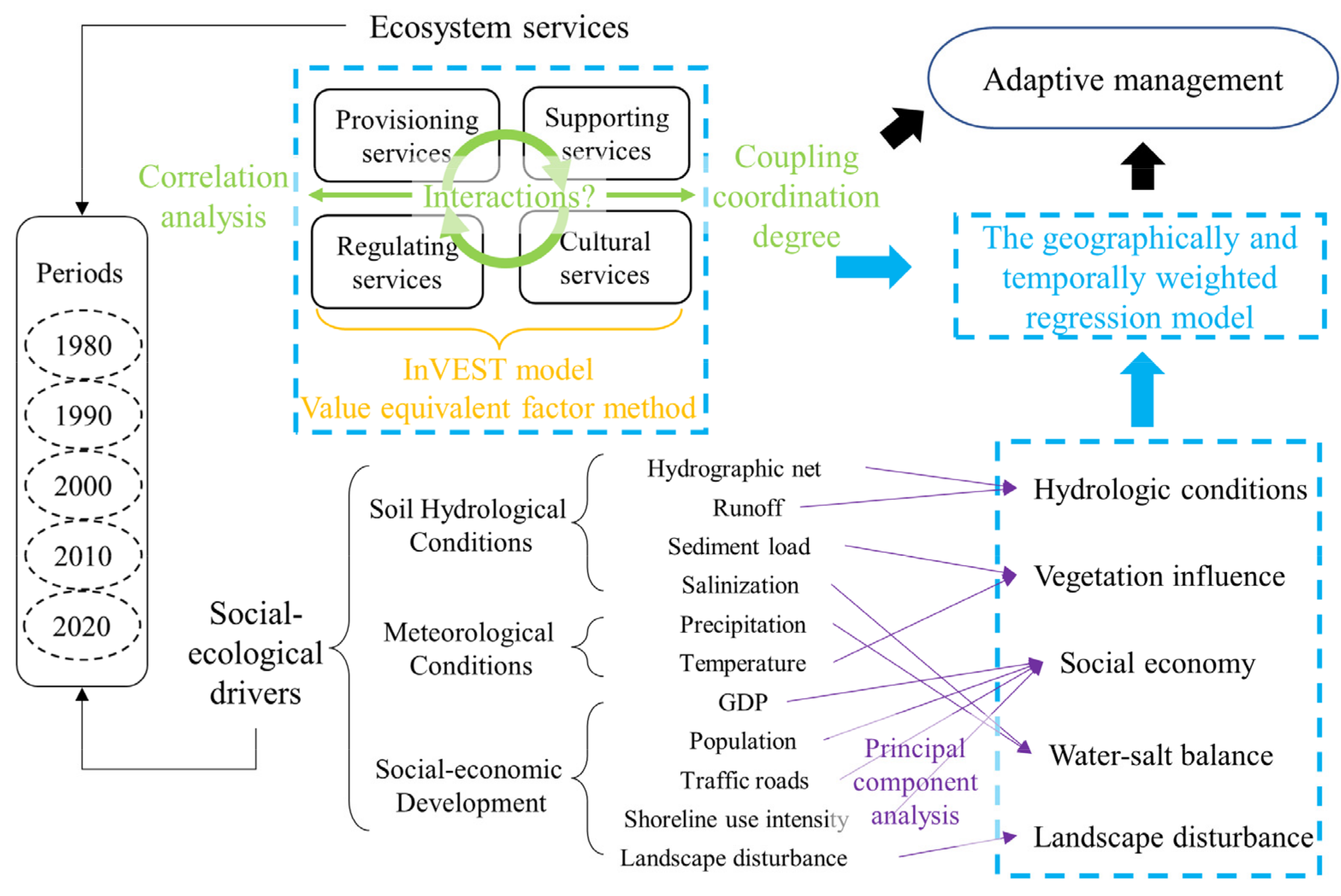
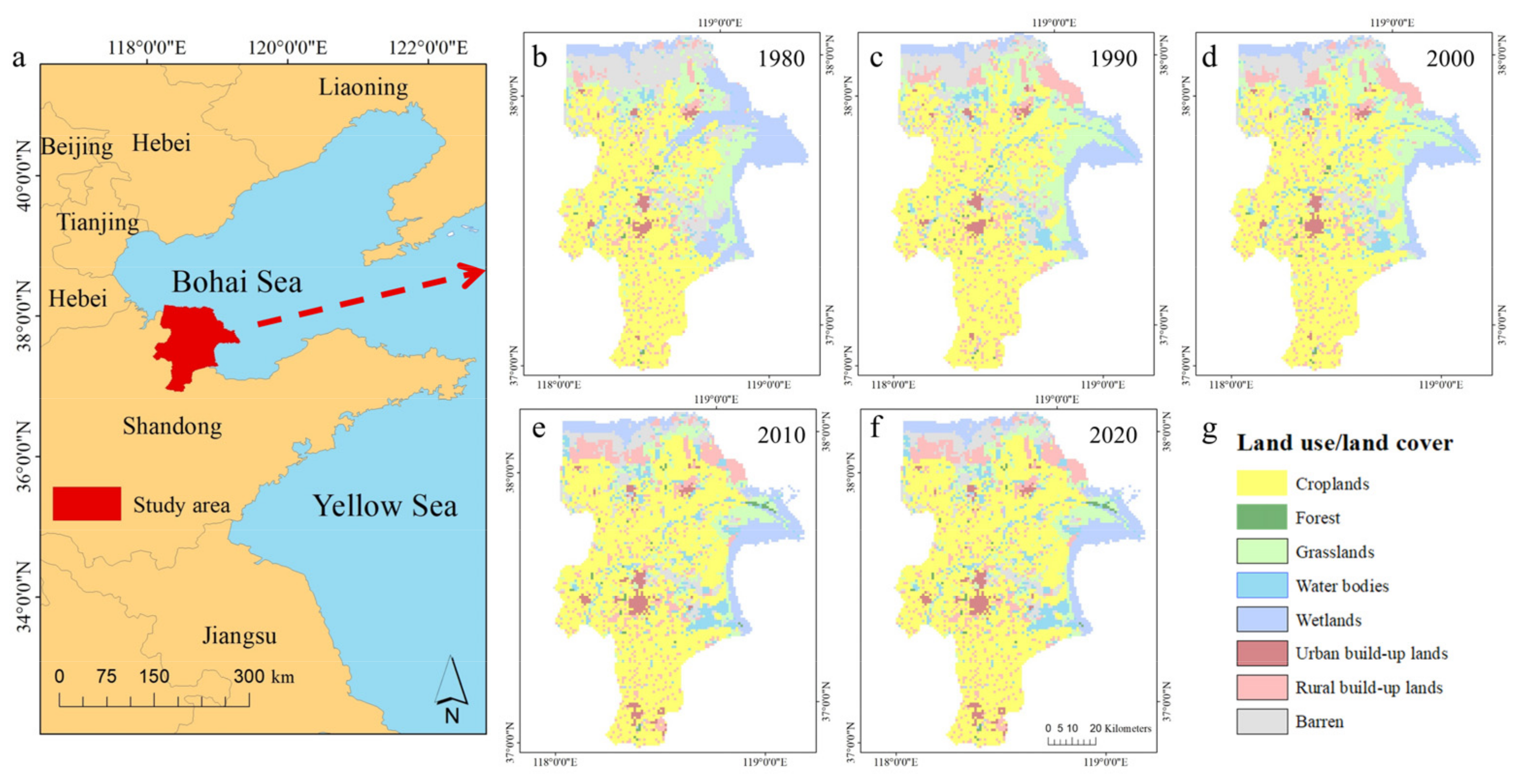

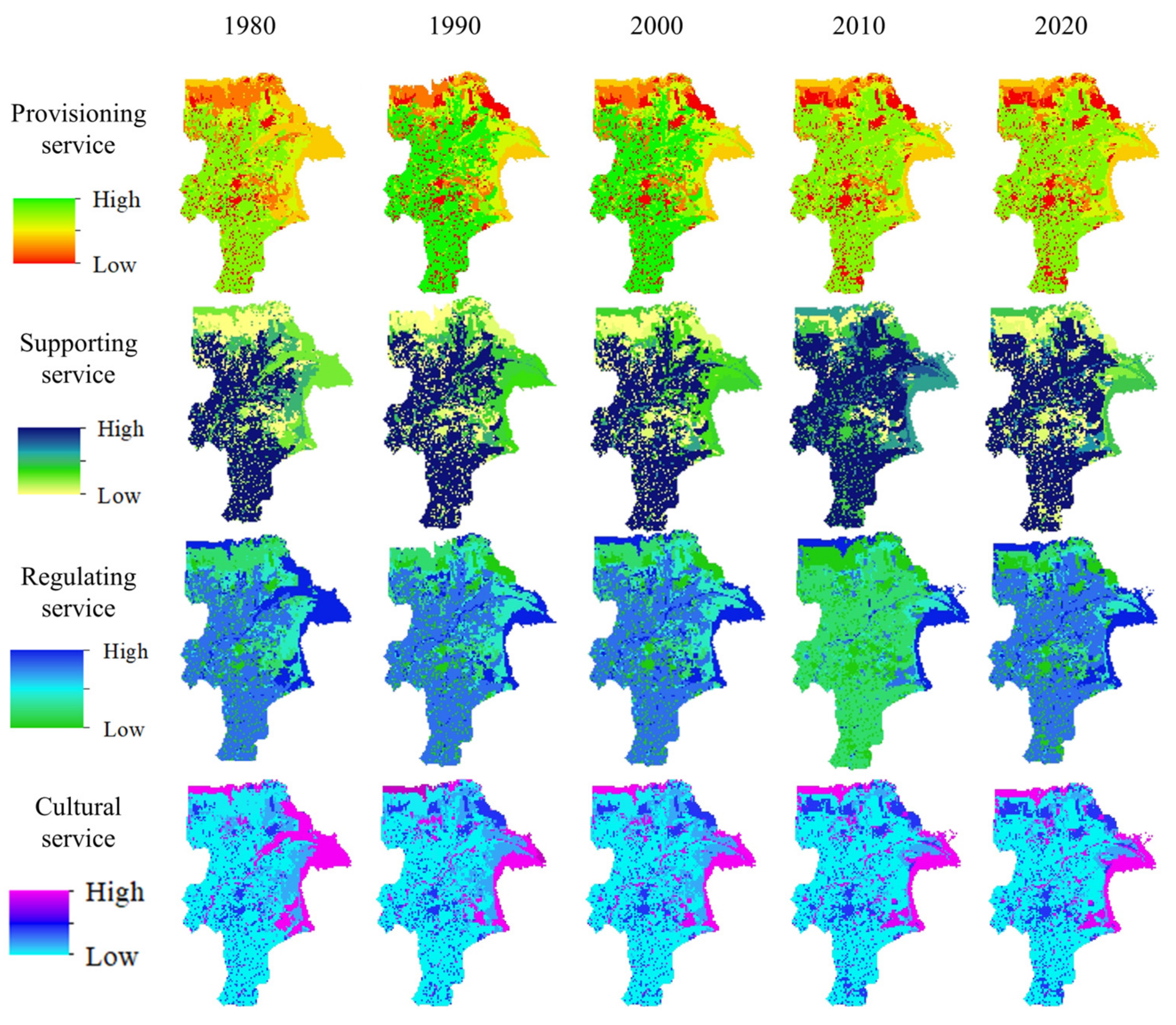
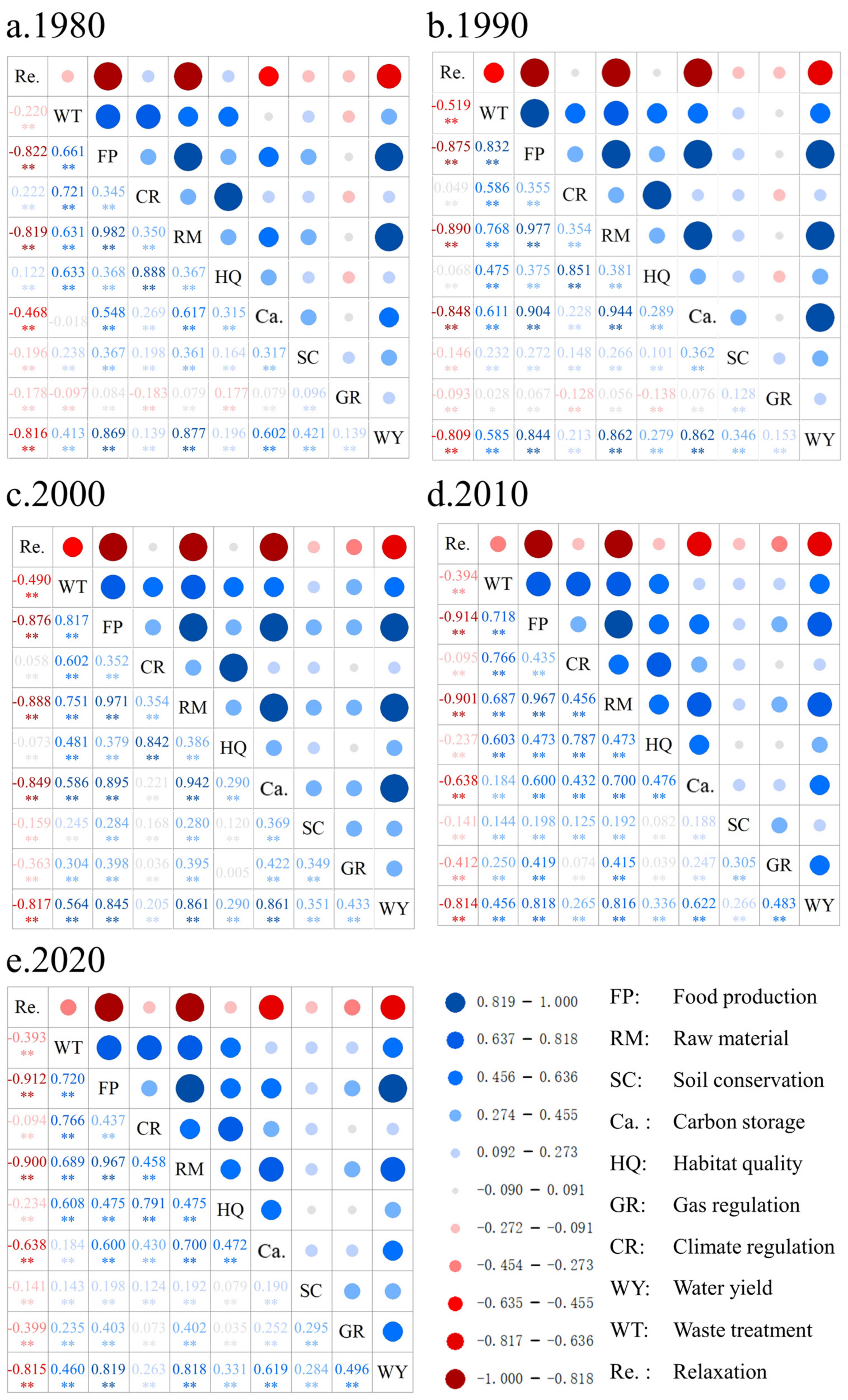
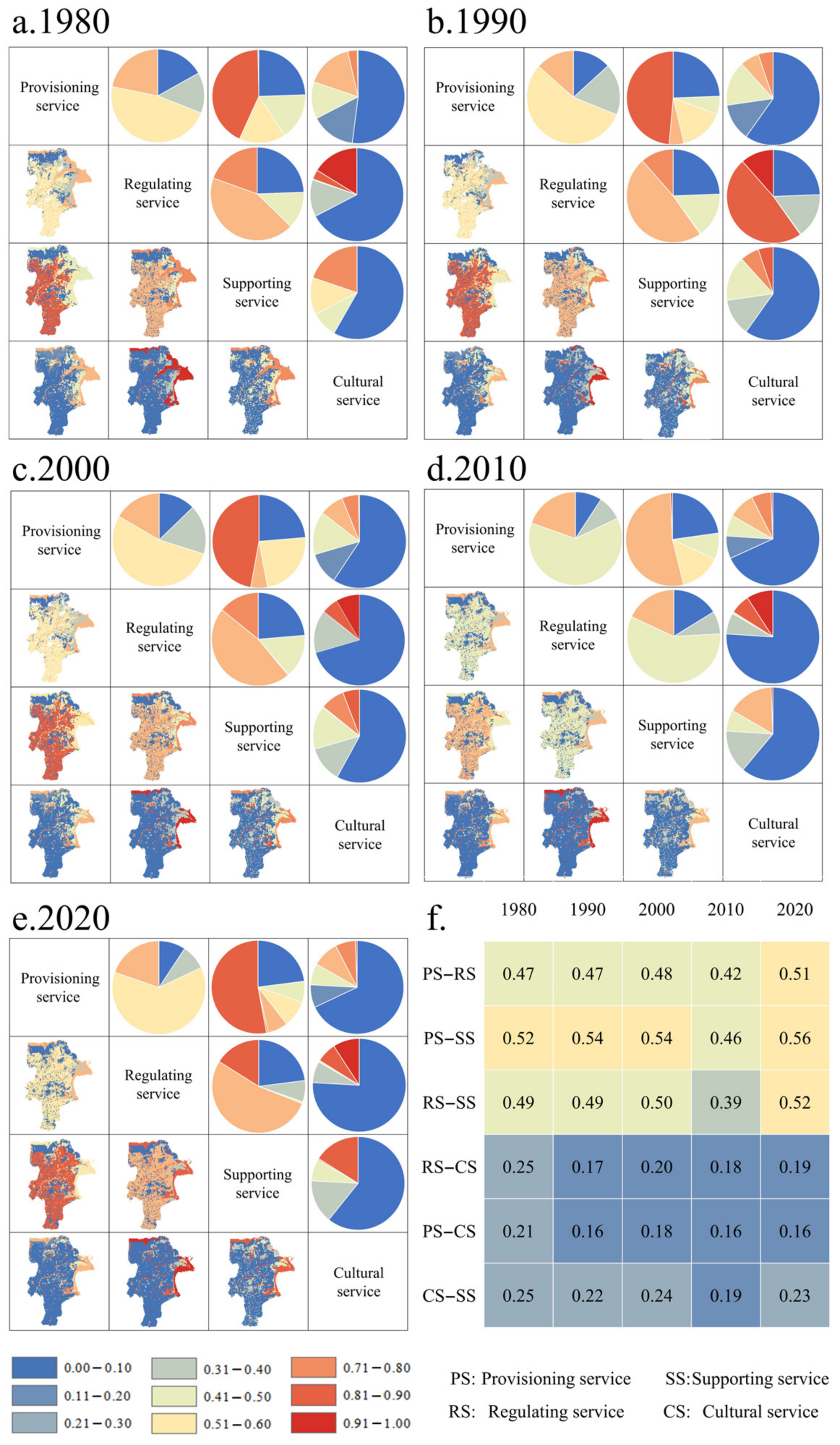
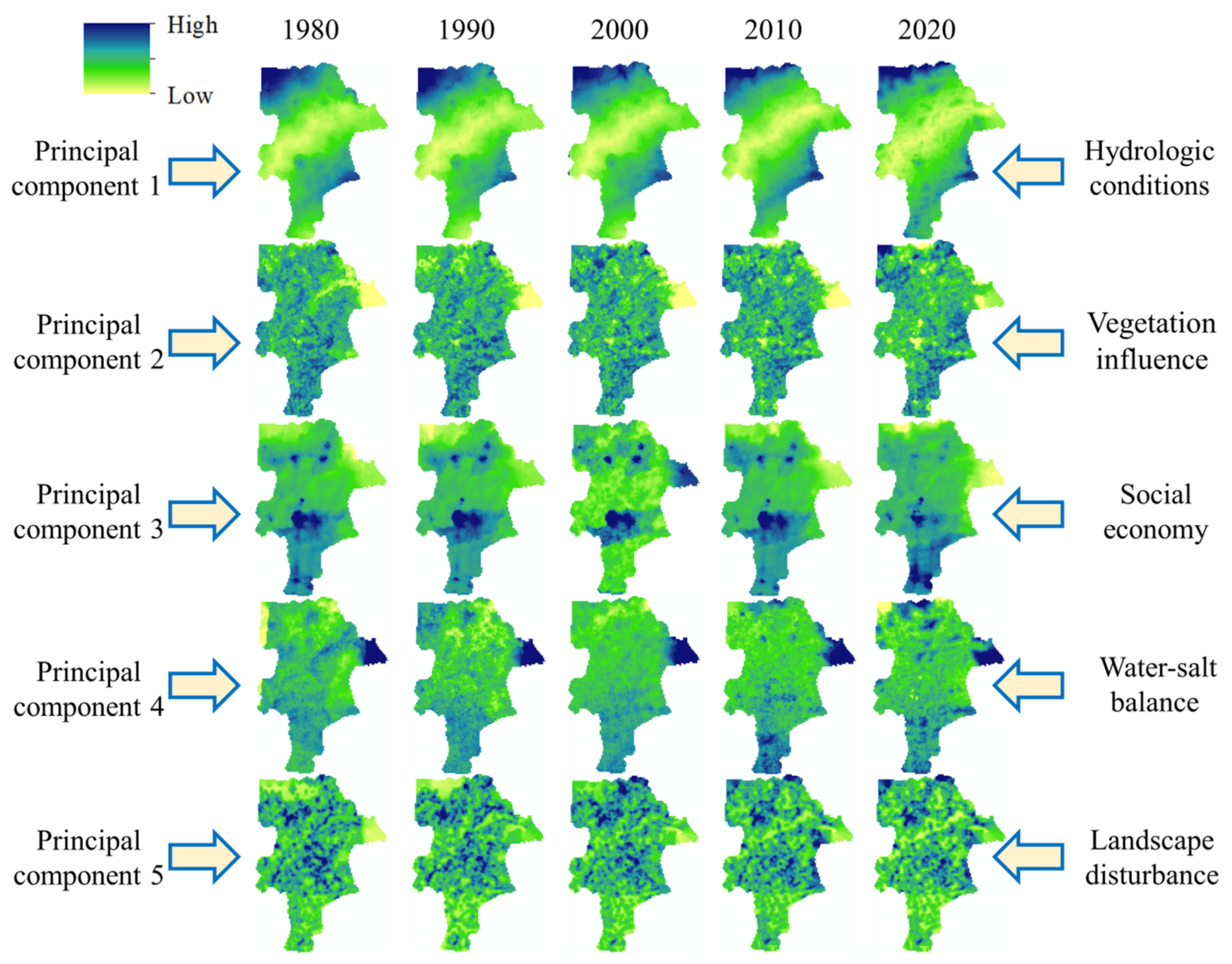
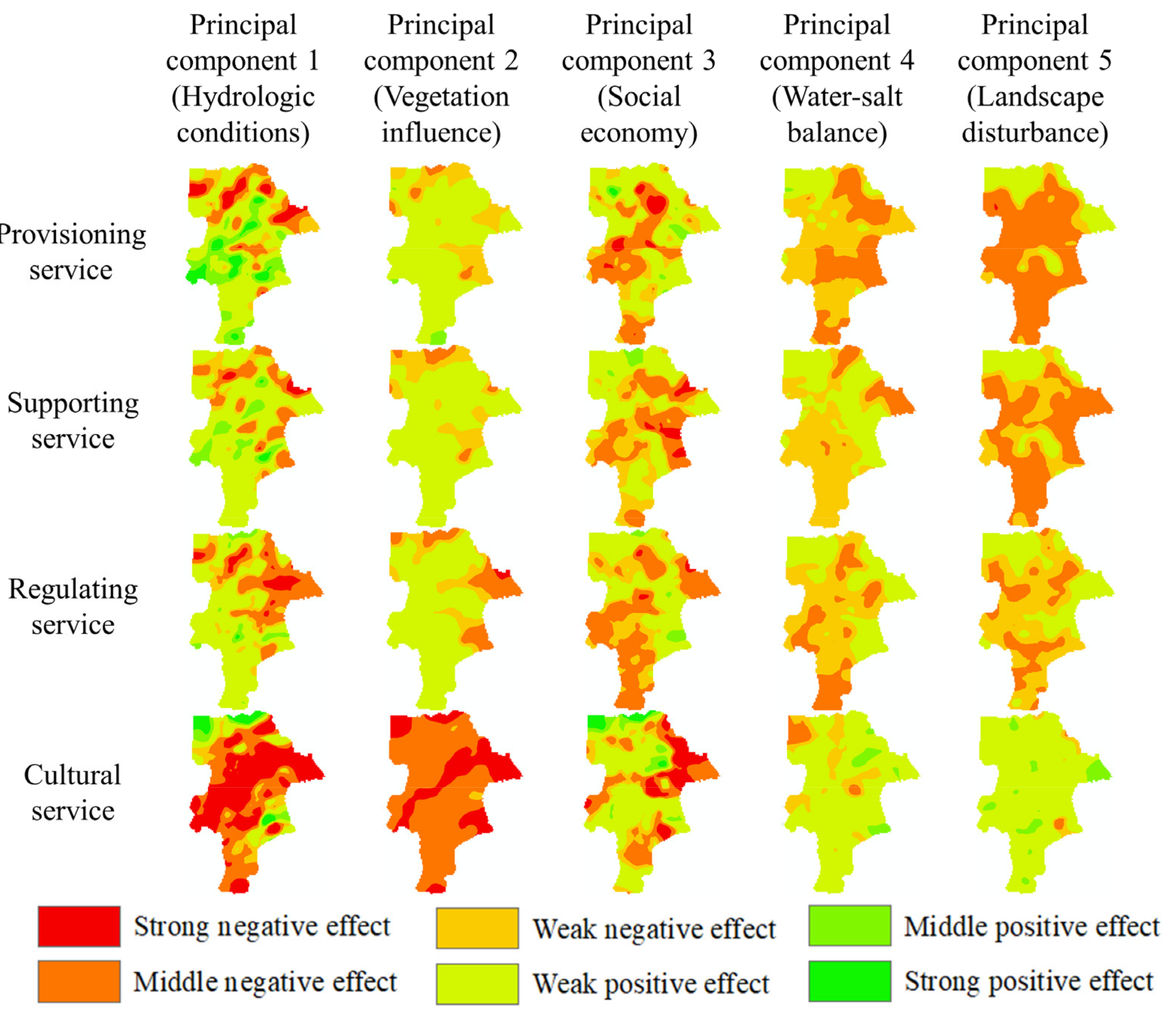
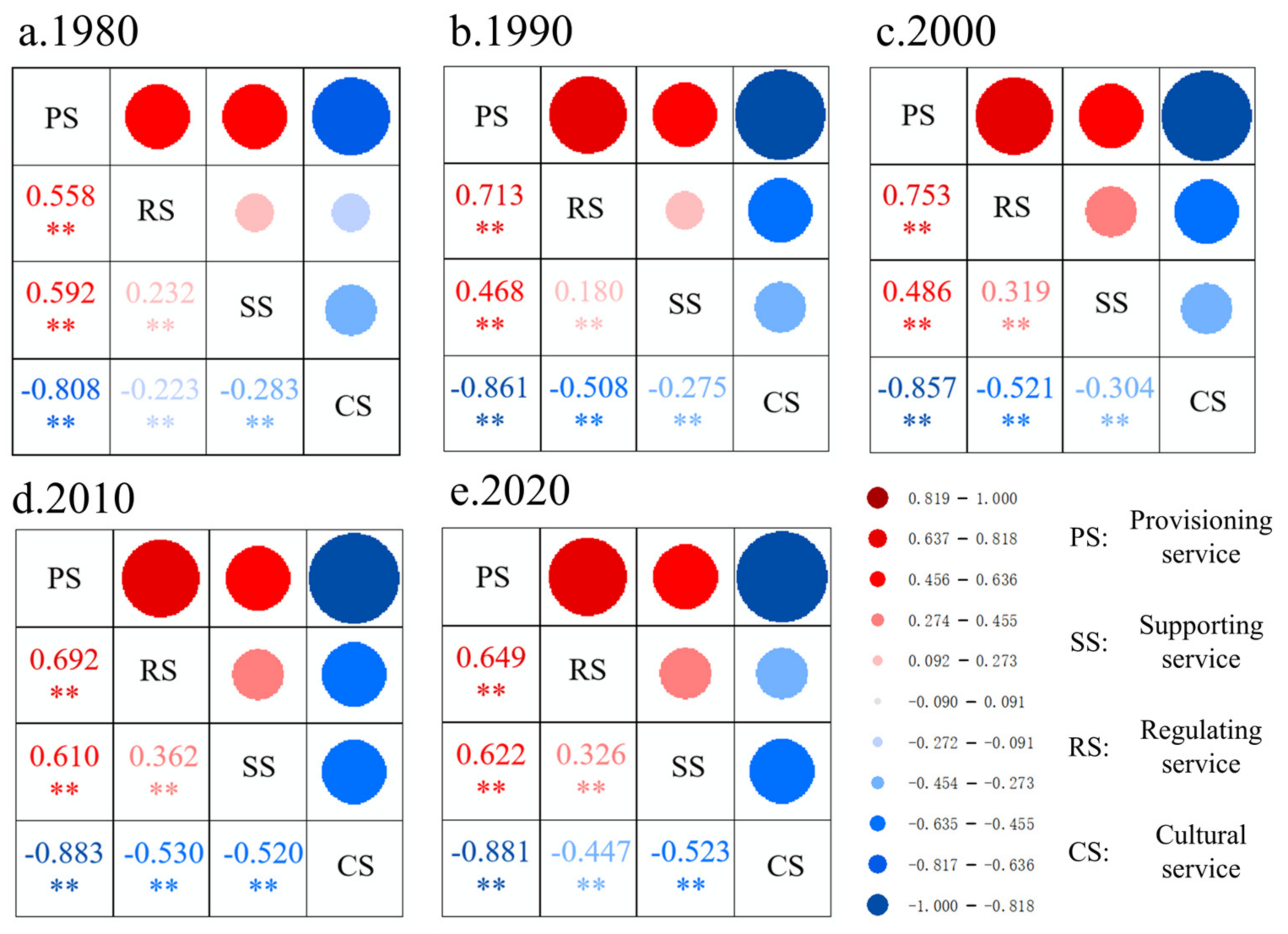

| Data Type | Data Source/Processing |
|---|---|
| LULC | Remote sensing monitoring data of LULCs in China (http://www.dsac.cn/DataProduct/Detail/200804) (accessed on 1 February 2023) |
| Precipitation | WorldClim Historical monthly weather data [23,24] (https://www.worldclim.org/data/monthlywth.html) (accessed on 1 February 2023) |
| Temperature | WorldClim Historical monthly weather data [23,24] (https://www.worldclim.org/data/monthlywth.html) (accessed on 1 February 2023) |
| Digital elevation model (DEM) | SRTMDEMUTM 90M Resolution DEM Products (https://www.gscloud.cn/sources/accessdata/306?pid=302) (accessed on 3 February 2023) |
| Net primary productivity (NPP) | 1 km raster dataset of monthly NPP of terrestrial ecosystems in China (http://www.geodoi.ac.cn/WebCn/doi.aspx?Id=1212) (accessed on 3 February 2023) |
| Rainfall erosivity | Rainfall erosivity mapping over mainland China based on high-density hourly rainfall records [25] (https://gda.bnu.edu.cn/sypt/sjgx/tdlytdfgsjj/111228.html) (accessed on 3 February 2023) |
| Hydrographic net | Euclidean distance from Yellow River |
| Gross domestic product (GDP) | Resource and Environment Science and Data Center (https://www.resdc.cn/DOI/DOI.aspx?DOIID=33) (accessed on 3 February 2023) |
| Population | WorldPop Open Population Repository (WOPR) (https://hub.worldpop.org/) (accessed on 7 February 2023) |
| Landscape disturbance | Remote sensing monitoring data of LULCs in China (http://www.dsac.cn/DataProduct/Detail/200804) (accessed on 1 February 2023) |
| Traffic roads | Euclidean distance from roads, whose data were obtained from OpenStreetMap (http://www.openstreetmap.org/) (accessed on 7 February 2023). |
| Shoreline use intensity | Geospatial Data Cloud (https://www.gscloud.cn/sources/index?pid=1&rootid=1) (accessed on 7 February 2023) |
| Salinization | Geospatial Data Cloud (https://www.gscloud.cn/sources/index?pid=1&rootid=1) (accessed on 7 February 2023 |
| Runoff | Yellow River Sediment Bulletin |
| Sediment load | Index of Connectivity |
| Category | Ecosystem Service | Formula | Paraphrase |
|---|---|---|---|
| Provisioning service | Food production | is the area of the cell i; n is the total number of cells; and is the value equivalent factor of food production. | |
| Raw material | is the area of the cell i; n is the total number of cells; and is the value equivalent factor of raw material. | ||
| Supporting service | Soil conservation | , and are the soil erosion amount every year, the potential soil erosion amount, and the soil conservation amount, respectively; is total nitrogen, phosphorus, and potassium nutrients in unit mass of soil [28,29]; and is average price of nitrogen, phosphorus and potassium fertilizers [30]. | |
| Carbon storage | is the carbon density of aboveground carbon storage (kg/km2); is the carbon density of underground carbon storage (kg/km2); is the carbon density in soil (kg/km2); is the carbon density of litter (kg/km2); and is the carbon fixation price [31]. | ||
| Habitat quality | is the area of the cell i; n is the total number of cells; and is the value equivalent factor of habitat quality. | ||
| Regulating service | Gas regulation | NPP is the annual net primary productivity; and is the price of oxygen [32]. | |
| Climate regulation | is the area of the cell i; n is the total number of cells; and is the value equivalent factor of climate regulation. | ||
| Water yield | is the water yield in cell i, is the mean reference evapotranspiration every year in cell I; is the precipitation every year in cell I; and is cost of unit reservoir capacity [33]. | ||
| Waste treatment | is the area of the cell i; n is the total number of cells; and is the value equivalent factor of waste treatment. | ||
| Cultural service | Relaxation | is the area of the cell i; n is the total number of cells; and is the value equivalent factor of relaxation. |
| Category | Nitrogen | Phosphorus | Potassium | Total |
|---|---|---|---|---|
| Content (%) | 0.050 | 0.055 | 2.65 | 2.755 |
| D Value Interval | Coupling Coordination Type |
|---|---|
| 0.0 < D ≤ 0.19 | Serious disorder |
| 0.2 < D ≤ 0.29 | Moderate disorder |
| 0.3 < D ≤ 0.39 | Mild disorder |
| 0.4 < D ≤ 0.49 | Almost disorder |
| 0.5 < D ≤ 0.59 | Slight coordination |
| 0.6 < D ≤ 0.69 | Primary coordination |
| 0.7 < D ≤ 0.79 | Moderate coordination |
| 0.8 < D ≤ 0.89 | High coordination |
| 0.9 < D ≤ 1.00 | Extreme coordination |
| Type of Drivers | Data |
|---|---|
| Meteorological conditions | Precipitation |
| Temperature | |
| Soil and hydrological conditions | Salinization |
| Runoff | |
| Sediment load | |
| Hydrographic net | |
| Social–economic development | GDP |
| Population | |
| Landscape disturbance | |
| Traffic roads | |
| Shoreline use intensity |
| Principal Component | Eigenvalue | Contribution Rate (%) | Cumulative Contribution Rate (%) |
|---|---|---|---|
| 1 | 1.851 | 16.824 | 16.824 |
| 2 | 1.834 | 16.668 | 33.493 |
| 3 | 1.700 | 15.450 | 48.943 |
| 4 | 1.633 | 14.847 | 63.791 |
| 5 | 1.066 | 9.693 | 73.484 |
| Driver | Principal Component | ||||
|---|---|---|---|---|---|
| 1 | 2 | 3 | 4 | 5 | |
| Hydrographic net | 0.926 | 0.231 | 0.029 | 0.000 | −0.008 |
| Temperature | −0.058 | 0.834 | 0.026 | 0.388 | 0.142 |
| Precipitation | −0.246 | 0.222 | 0.308 | 0.683 | −0.068 |
| Traffic roads | 0.438 | −0.238 | −0.550 | 0.222 | −0.173 |
| Landscape disturbance | −0.042 | −0.062 | 0.022 | 0.011 | 0.956 |
| Population | −0.020 | −0.161 | 0.650 | −0.019 | 0.005 |
| GDP | 0.168 | 0.002 | 0.795 | 0.174 | 0.024 |
| Shoreline use intensity | 0.418 | −0.061 | −0.478 | −0.268 | 0.188 |
| Salinization | 0.025 | 0.044 | −0.049 | 0.879 | 0.047 |
| Runoff | −0.726 | 0.494 | −0.075 | 0.296 | 0.128 |
| Sediment load | 0.068 | 0.836 | −0.102 | −0.066 | −0.209 |
Disclaimer/Publisher’s Note: The statements, opinions and data contained in all publications are solely those of the individual author(s) and contributor(s) and not of MDPI and/or the editor(s). MDPI and/or the editor(s) disclaim responsibility for any injury to people or property resulting from any ideas, methods, instructions or products referred to in the content. |
© 2023 by the authors. Licensee MDPI, Basel, Switzerland. This article is an open access article distributed under the terms and conditions of the Creative Commons Attribution (CC BY) license (https://creativecommons.org/licenses/by/4.0/).
Share and Cite
Yin, L.; Zheng, W.; Shi, H.; Wang, Y.; Ding, D. Spatiotemporal Heterogeneity of Coastal Wetland Ecosystem Services in the Yellow River Delta and Their Response to Multiple Drivers. Remote Sens. 2023, 15, 1866. https://doi.org/10.3390/rs15071866
Yin L, Zheng W, Shi H, Wang Y, Ding D. Spatiotemporal Heterogeneity of Coastal Wetland Ecosystem Services in the Yellow River Delta and Their Response to Multiple Drivers. Remote Sensing. 2023; 15(7):1866. https://doi.org/10.3390/rs15071866
Chicago/Turabian StyleYin, Liting, Wei Zheng, Honghua Shi, Yongzhi Wang, and Dewen Ding. 2023. "Spatiotemporal Heterogeneity of Coastal Wetland Ecosystem Services in the Yellow River Delta and Their Response to Multiple Drivers" Remote Sensing 15, no. 7: 1866. https://doi.org/10.3390/rs15071866
APA StyleYin, L., Zheng, W., Shi, H., Wang, Y., & Ding, D. (2023). Spatiotemporal Heterogeneity of Coastal Wetland Ecosystem Services in the Yellow River Delta and Their Response to Multiple Drivers. Remote Sensing, 15(7), 1866. https://doi.org/10.3390/rs15071866







